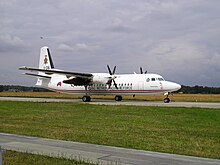Fokker 50


The Fokker 50 is a turboprop-powered airliner, designed as a refinement of and successor to the highly successful Fokker F27 Friendship.
History
The Fokker 50 was designed after sales of the Fokker F27 Friendship, which had been in continual production since 1958, were beginning to decline by the 1980s. Fokker management, notably Frans Swarttouw, decided that an aircraft with aerodynamic and electronic updates from both the Fokker F27 and the Fokker F28 (the short-range twin jet for 85 passengers) was sensible. Design of the Fokker 50 started in 1983.
Certification of the Fokker 50 (initially known as the Fokker F27 Mk050 or Fokker 50) by the Dutch aviation authority RLD was successfully completed in 1987 after four years of design review and flight testing. First delivery was made to DLT of Germany. Production ended in 1996 after the Fokker Aircraft Company went into liquidation. By the end of the program, 213 Fokker 50s had been produced. In 2005 a majority of these were in operational service and in August 2006 a total of 171 Fokker 50 aircraft remain in airline service. Major operators include: Malaysia Airlines (10) (now operated by FlyAsianXpress and Firefly), Denim Air (12), KLM Cityhopper (16), Skyways Express (18) and VLM Airlines (20). Some 27 other airlines also operate smaller numbers of the type.[1]
Design
The Fokker 50 was based on the stretched F27-500 airframe, but with a larger number of smaller windows in the fuselage and a two-wheel nose gear.
Basic construction of the fuselage, wings and empennage (tail) remained unchanged apart from strengthening the various sections where required. The wing was equipped with upturned aileron and wingtips, effectively acting as wing endplates or winglets.
The major design change from the Fokker F27 was in the engines, and in equipping the aircraft with an electronic flight and engine-management system. The original Rolls-Royce Darts in various marks of basically 1700 to 2300 HP was replaced with two more fuel efficient Pratt & Whitney Canada PW124 powerplants of max 2500 HP each, driving a 6 bladed Dowty Rotol propeller.
Compared to the Fokker F27, the Fokker 50 can carry around 50 passengers over a range of 2000 km at a typical speed of 530 km/h, a 50 km/h increase over the Fokker F27.
Current operators
The following airlines or military operators currently fly the Fokker 50 in passenger or cargo roles:
- Aero Condor
- Aero Mongolia
- Air Astana
- Air Baltic
- Air Central
- Air Iceland
- Albanian Airlines
- Alliance Airlines
- Amapola Flyg
- Aria Air
- Avianca (only operator of the -300 series)
- Crescent Air Cargo
- Denim Air
- Ethiopian Airlines
- FlyAsianXpress
- Firefly
- Iranian Air Transport
- Kish Airline
- KLM Cityhopper
- KLM Cityhopper UK
- KLM
- Mandarin Airlines
- OceanAir
- Palestinian Airlines
- PT Indonesia Air Transport
- PT Transwisata Prima Aviation
- PT. Riau Airlines
- Republic of China Navy - as VIP transport
- Republic of Singapore Air Force
- SAS Braathens
- Skyways Express
- Skywest Airlines
- Sudan Airways
- SWE FLY AB
- Taftan Air
- Tanzania Government Flight Agency
- VLM Airlines
http://www.fokkerservices.com/page.html?ch=DEF&id=5718
Specifications (Fokker 50 series 100)
| This aircraft article is missing some (or all) of its specifications. If you have a source, you can help Wikipedia by adding them. |
General characteristics
- Crew: Two (pilot & co-pilot)
- Capacity: Up to 58 passengers
Performance
Armament
- 2 × AGM-84D Harpoon missiles and radar, sonar systems (Republic of Singapore Air Force Fokker 50s)
References
- ^ Flight International, 3-9 October 2006
External links
Related content
Related development
Aircraft of comparable role, configuration, and era
- Antonov An-140
- ATR 42 and 72
- de Havilland Canada Dash 8
- Embraer EMB 120 Brasilia
- Fairchild-Dornier 328 family
- Ilyushin Il-114
- Saab 2000 and 340
- Xian MA60/Xian Y-7/Antonov An-24
Related lists
